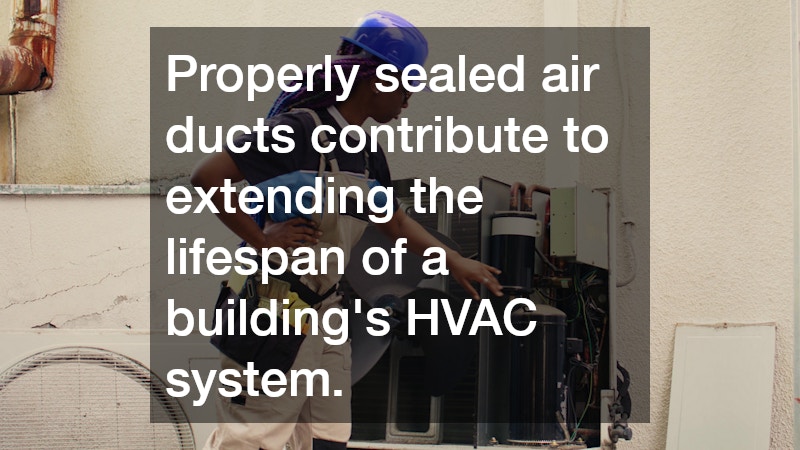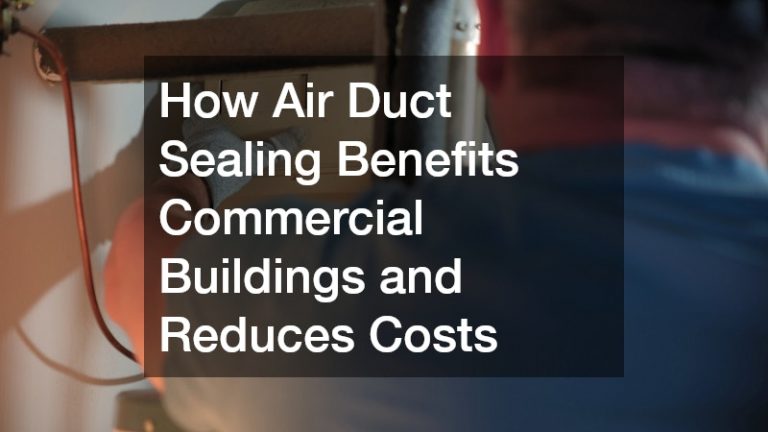Air duct systems are an integral part of commercial buildings, ensuring proper ventilation and maintaining comfortable indoor air quality. Yet, many business owners overlook the importance of maintaining these systems, particularly through air duct sealing. This article explores the benefits of air duct sealing for commercial buildings, revealing how this practice can lead to significant cost reductions and enhanced environmental control.
Improved Energy Efficiency
One of the primary benefits of air duct sealing is improved energy efficiency within a commercial building. When ducts are not properly sealed, energy loss through leaks can account for a large portion of a building’s total energy consumption.
This results in prolonged operation times for heating and cooling systems, thus driving up energy costs to unnecessarily high levels. By sealing the ducts, the efficiency of HVAC systems is greatly enhanced, ensuring that energy is not wasted. Consequently, businesses can see a marked decrease in their energy bills, allowing resources to be allocated to other vital areas.
Air duct leaks disrupt the balance of pressure throughout a building, often leading to overuse of HVAC units. Sealing these leaks helps maintain consistent pressure levels, preventing systems from working harder than necessary. This not only decreases energy costs but also supports sustainability efforts by reducing carbon emissions associated with excessive energy use. As awareness around environmental responsibility grows, businesses can gain reputational benefits from showcasing their commitment to green practices.
Beyond financial savings and environmental impact, improved energy efficiency through duct sealing contributes to better system performance. HVAC systems can reach and maintain desired temperatures more quickly and effectively when air duct systems are properly sealed. This can also prolong the lifespan of these units by reducing wear and tear over time, leading to fewer repair costs and better overall return on investment.
Enhanced Indoor Air Quality
Another critical advantage of air duct sealing is the enhancement of indoor air quality. Leaky ducts often permit dust, allergens, and pollutants to enter the air circulation system, posing health risks to building occupants. Sealing these leaks helps ensure that the air being circulated is cleaner and healthier. This is particularly important in workplaces, where poor air quality can lead to issues such as increased absenteeism and reduced productivity.
Improving air quality in a commercial building through proper duct sealing can significantly reduce health-related complaints among employees. Conditions such as allergies and respiratory problems are often exacerbated by poor indoor air environments. By preventing contaminants from entering the air supply, businesses can foster a healthier workplace, ultimately benefiting overall employee well-being and efficiency.
Building owners may also experience fewer complaints from tenants or customers regarding air quality when air ducts are properly managed. Satisfaction among occupants is a key factor in tenant retention and customer loyalty. Therefore, maintaining air ducts can contribute to a positive reputation and increase the appreciation and trust stakeholders have in the building’s infrastructure, eventually leading to financial benefits.
Extended HVAC System Longevity
Properly sealed air ducts contribute to extending the lifespan of a building’s HVAC system. Leaks in the ductwork force these systems to work harder, frequently leading to overuse and increased maintenance needs. By addressing these inefficiencies through air duct sealing, HVAC systems experience less strain and perform optimally over their intended lifecycle.
This practice of maintaining the ductwork can significantly reduce the frequency and cost of repairs. Regularly sealed ducts ensure that major breakdowns are less likely to occur, providing peace of mind to building operators. Furthermore, fewer instances of costly emergency repairs contribute to a more predictable property management budget.
With a reduced need for system replacements and repairs, businesses can allocate financial resources more effectively. The initial investment in duct sealing often pays for itself through lowered operational and maintenance costs. Additionally, having a reliable HVAC system reduces unexpected disruptions to daily business operations, maintaining productivity and fostering an uninterrupted work environment.
In summary, the benefits of air duct sealing in commercial buildings are vast and far-reaching. From improved energy efficiency and enhanced air quality to extended HVAC system longevity, the positive impacts are both financial and environmental. Business owners and building managers who prioritize duct sealing can expect to see a decrease in costs and an improvement in indoor environmental quality.
As energy costs continue to rise and the demand for sustainability grows, the decision to invest in air duct sealing becomes increasingly crucial. By addressing leaky ducts, companies can better manage their energy consumption and take control of their operational costs. This proactive measure not only benefits the bottom line but also contributes to the broader goal of creating more sustainable, healthy, and efficient commercial environments.
Ultimately, air duct sealing represents a practical and effective strategy for maintaining the integrity and performance of commercial buildings. By applying this important practice, businesses stand to gain long-term advantages that align with both economic and environmental priorities. As such, integrating duct sealing into regular building maintenance schedules is a smart move for any forward-thinking commercial property owner.





